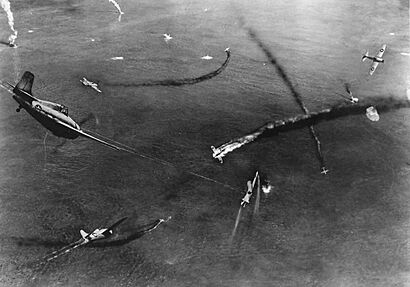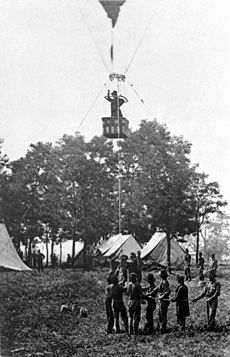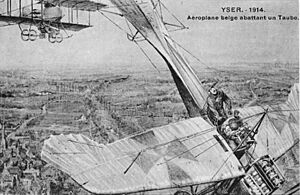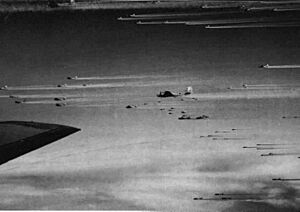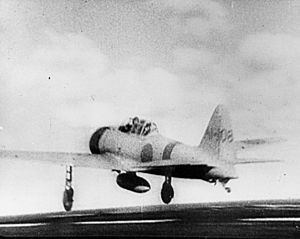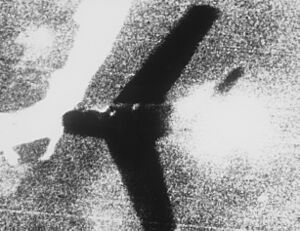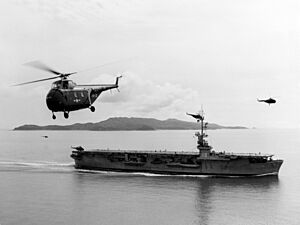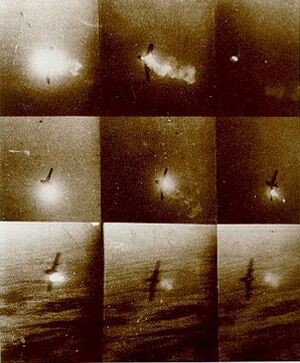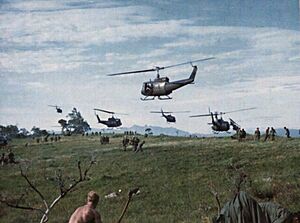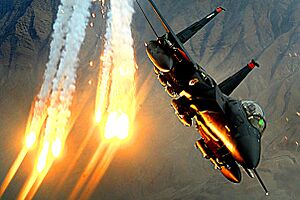History of aerial warfare facts for kids
The history of aerial warfare is about how people have used flying objects in wars. It started long ago in China with kites. Later, in the third century, people used balloons for fighting. Airplanes first joined wars in 1911. At first, they were used to scout and see what the enemy was doing. Then, planes started fighting each other to stop these scouting missions.
During World War II, planes began dropping bombs on important enemy targets far away. This was called strategic bombing. Also in World War II, Nazi Germany created new weapons like the first missiles and guided bombs. These included the first cruise missiles and ballistic missiles. After World War II, during the Cold War, ballistic missiles became very important. They carried nuclear bombs and were used by the United States and the Soviet Union to scare each other from attacking.
Contents
Imagining Air Battles
For a long time, people dreamed about flying and using that ability in wars. Ancient stories told of gods who could fly and throw lightning. There were also tales of humans like Daedalus and Icarus who found ways to fly. It was a natural step to imagine people flying and fighting battles in the sky. These ideas came long before the technology existed to make them real.
In a book called Gulliver's Travels (1726) by Jonathan Swift, there's a king who lives on a flying island. He drops big rocks from the sky onto his enemies.
Maybe the first detailed story about an Air Force was in "The Wicked Prince" by Hans Christian Andersen (1840). In this story, a cruel prince builds a huge flying ship. It has thousands of gun barrels that can fire bullets in all directions. Later, he makes even better ships that shoot "Steel Thunderbolts." He builds thousands of these to create a giant air fleet for his army.
H.G. Wells wrote The War in the Air (1907). He understood how much air power would change warfare. Many of his ideas, like bombing cities or how air attacks would make big battleships useless, came true in the Second World War. This was much later than the First World War, which started just a few years after his book.
Early Flying Warfare
Kites in Battle
The first time we know of flying objects being used in war was in ancient China. People used manned kites to spy on enemies and send messages. This helped them gather military intelligence.
Balloons in War
Balloons were also used in early warfare.
Chinese Lanterns
Around the second or third century, the Kongming lantern was invented in China. This was an early type of hot air balloon. It was used to send signals during battles.
Balloons in Europe
Balloons were used a little bit when flying was still new. The French Aerostatic Corps used a balloon called L'entreprenant in 1794 at the Battle of Fleurus. It was tied to the ground and helped them see the battlefield better.
But balloons had problems. They couldn't fly in bad weather, fog, or strong winds. They were also big, easy targets.
Austrian Attack on Venice (1849)
The first time balloons were used to attack was in 1849. Austrian forces were trying to capture Venice. They tried to float about 200 paper hot air balloons over the city. Each balloon carried a bomb weighing 24–30 pounds (11–14 kg). The bombs had a timer to drop over the city. Most balloons were launched from land, but some came from a ship called SMS Vulcano. The Austrians used smaller balloons first to figure out the right bomb timing. At least one bomb hit the city. But the wind changed, so most balloons missed their target. Some even drifted back over the Austrian lines!
American Civil War Balloons

The American Civil War was the first war where flying objects were used a lot to help in battles. Professor Thaddeus S. C. Lowe helped the Union Army a lot with his balloons. In June 1861, he offered his services to President Lincoln. Lincoln was interested in the idea of using air power. Lowe showed that he could fly a balloon over Washington, D.C., and send a telegraph message to the ground. This led him to work with army engineers. At first, they thought balloons could help make better maps.
Lowe's first mission was to fly freely and observe the Confederate positions at the First Battle of Bull Run in July 1861. He then used flag signals to guide artillery fire onto enemy camps.
Lowe and other balloonists formed the Union Army Balloon Corps. Lowe insisted that balloons be tied down (tethered). He worried about being shot down over enemy lines and treated as a spy. By flying from 1,000 feet (300 m) to as high as 3.5 miles (5.6 km), they could see a huge area of the battlefield.
As the Confederates moved back, the war turned into the Peninsular Campaign. The thick forests there made it hard for balloons to follow on land. So, a coal barge was turned into a balloon carrier. The balloons and their gas generators were put on board. This allowed them to continue scouting the peninsula.
At the Battle of Fair Oaks, Lowe saw the enemy army advancing. He quickly sent a message to call for backup troops.
The balloon corps was later moved to the engineers' group. By August 1863, the Union Army Balloon Corps was stopped.
The Confederate Army also used balloons. But they had very few supplies because of trade blockades. They had to make their balloons from colored silk dress fabric. Their use was limited because gas was hard to get in Richmond, Virginia. By the summer of 1863, all balloon scouting in the American Civil War had ended.
Before World War I: Planes Take Flight
Before World War I, some countries agreed not to drop bombs from balloons or planes. This was part of the 1907 Hague Convention.
The United States Navy became interested in planes for naval use. In August 1910, Jacob Earl Fickel tested shooting a gun from an airplane with Glenn Curtiss. In 1910–1911, the Navy showed that planes could take off and land on ships. On November 14, 1910, Eugene Ely took off from a wooden platform on the ship USS Birmingham. He landed safely on shore. A few months later, on January 18, 1911, Ely landed on a platform on the ship USS Pennsylvania in San Francisco harbor. This proved planes could land on ships too.
The first time airplanes were used in a real war was in the 1911 Italo-Turkish War. Italian planes bombed a Turkish camp in Libya. In the First Balkan War (1912), the Bulgarian Air Force bombed Turkish positions. The Greek Aviation worked with the navy for the first time, flying over the Dardanelles.
The United States Army used planes for scouting and sending messages in its 1916–1917 fight against Pancho Villa. Airplanes also dropped bombs during the First Balkan War, including the first night bombing in November 1912. The German air service later used air-dropped bombs in World War I.
World War I: Dogfights and Bombers
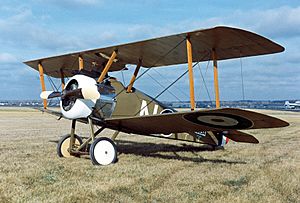
In World War I, both sides first used balloons and planes to watch the enemy and guide artillery fire. At first, pilots just waved at each other. But soon, they wanted to stop enemy planes from seeing their positions. So, pilots started attacking other planes and balloons, first with small guns they carried.
In April 1915, French pilot Roland Garros and designer Raymond Saulnier added metal plates to their plane's propeller. This allowed the plane to fire a gun through the propeller. Garros used this to shoot down three enemy planes. Later in 1915, Anthony Fokker, a Dutch designer, created a successful synchronization gear. This device allowed a machine gun to fire between the spinning propeller blades without hitting them. On July 1, 1915, German pilot Kurt Wintgens got the first confirmed kill with a synchronized gun.
The Allies quickly developed their own synchronizers. This led to the start of aerial combat, also known as dogfighting. Pilots learned new fighting moves through practice. The German ace Oswald Boelcke created eight important rules for dogfighting, called the Dicta Boelcke.
Both sides also used planes for bombing, shooting at ground targets (strafing), scouting the sea, fighting submarines, and dropping propaganda leaflets. The German military used Zeppelins and later bombers like the Gotha G.IV to drop bombs on Southern England. By the end of the war, planes had become specialized. There were bombers, fighters, and observation (scouting) planes. By 1916, dogfighting tactics like the Dicta Boelcke helped gain control of the sky, known as air supremacy. During the war, new plane designs meant that control of the air shifted back and forth between Germany and the Allies.
Between the World Wars
Between 1918 and 1939, airplane technology grew very fast. In 1918, most planes were biplanes (two wings) made of wood and canvas. By 1939, military biplanes were being replaced by metal monoplanes (one wing). These new planes were much faster, could fly higher, and bombers could carry more bombs over longer distances.
Some experts, especially in Britain, thought that planes would be the most important military weapon in the future. They believed that a future war could be won just by destroying the enemy's factories and military from the air. An Italian general named Giulio Douhet wrote a book called The Command of the Air. He was a key thinker in this idea. This led to the idea of deterrence, where countries built many bombers to scare others from attacking.
Others, like General Billy Mitchell in the United States, saw how air power could make naval fleets stronger. During World War I, German and British pilots tried bombing ships and dropping torpedoes from the air, with mixed results. On July 21, 1921, General Mitchell's bombers sank the old German battleship SMS Ostfriesland with bombs. Even though the Ostfriesland was not moving or fighting back, its destruction showed how powerful planes could be against ships.
During the Banana Wars, U.S. United States Marine Corps pilots fought bandits and rebels in places like Haiti and Nicaragua. They started to experiment with air-ground tactics to help Marines on the ground. In Haiti, they tried dive bombing. In Nicaragua, they made it even better. Marine pilots were the first to make this a regular part of their fighting plans.
Germany was not allowed to have an air force after World War I. But the German military secretly trained pilots. They formed a flying club called the Deutscher Luftsportverband to train civilians. Some German pilots even trained secretly in the Soviet Union. So, when Adolf Hitler decided to openly defy the ban, a trained air force was ready. This was the start of the Luftwaffe.
World War II: Air Power Takes Center Stage
Military aviation became extremely important during the Second World War. Planes could fly faster, farther, and carry more bombs. This meant air power was no longer just a new idea. It became a main fighting force for all countries involved.
During the war, planes were used in several key ways.
Strategic Bombing
Strategic bombing means bombing enemy cities and factories far behind the front lines. The Italian expert General Giulio Douhet first suggested this. In his 1921 book, The Command of the Air, he argued that future wars could avoid the bloody trench warfare of World War I. He believed that planes could attack enemy civilians directly. Douhet thought these attacks would make people force their governments to give up.
Britain and the United States became the biggest supporters of strategic bombing. Both countries built special heavy bombers for this job.
- Japanese Strategic Bombing
Japan also used strategic bombing, mostly against large Chinese cities. They also bombed cities in the Philippines, Australia, Burma, and Malaysia. Japanese planes also used tactical bombing against ships and military targets, like at Pearl Harbor.
- Luftwaffe (German Air Force)
Early in World War II, the Luftwaffe launched huge air attacks against cities under siege. During the Battle of Britain, the Luftwaffe couldn't gain control of the air. So, they started bombing British cities. But these raids did not make the British surrender as some had predicted.
- Soviet Red Air Force
The Soviet Union had many factories in the 1930s. This could have made their air force strong against the Luftwaffe. But Stalin's purges weakened the Soviet Air Forces. Still, when Germany invaded in June 1941, the Soviet Air Forces were so big that they could lose many planes and still keep fighting. Even though Soviet forces almost collapsed in 1941, they survived. German forces stretched their supply lines too far, and the Americans and British sent help.
Strategic bombing aims to destroy the enemy's ability to make war supplies. Some Soviet factories were moved far away from German bombers. The Luftwaffe had to use most of its planes to support the German army. This stretched them too thin. By 1943, the Soviets could make many more planes than Germany. For example, at Kursk, the Soviets had twice as many planes as the Luftwaffe. With so many planes, the Soviets pushed the Germans out of their territory and took the war to Germany.
- Allied Air Forces in Europe
Britain started a strategic bombing campaign in 1940 that lasted the rest of the war. Early British bombers were twin-engined. The 1939 Battle of the Heligoland Bight showed that bombers were easy targets for fighters. So, RAF Bomber Command decided to bomb large areas at night. Later in the war, special tactics, radio navigation, and radar helped them hit specific targets.
When the USAAF (U.S. Army Air Forces) arrived in England in 1942, they believed they could bomb successfully during the day. The U.S. Eighth Air Force used large, four-engined bombers that flew high. These new bombers also had more defensive guns. The U.S. believed that flying in large groups of heavy bombers would be enough to gain air superiority without fighter escorts. They planned to hit key parts of the German war economy, like oil refineries or ball bearing factories.
But the USAAF had to change its plan. Bombers alone, even with many guns, could not win air superiority against single-engined fighters. In a series of missions in 1943 that went beyond the range of fighter cover, up to 20% of the bombers were lost. The Allies lost 160,000 airmen and 33,700 planes during World War II. Almost 68,000 U.S. airmen died.
- Air Superiority
During the Battle of Britain, many of the best Luftwaffe pilots were captured. As the quality of the Luftwaffe fighter pilots went down, the Americans brought in long-range escort fighters. These planes, like the North American P-51 Mustang, carried extra fuel tanks. Newer, less experienced German pilots, even with good planes, became less effective at stopping the large groups of bombers later in the war. Adding fighters to daylight raids gave bombers much-needed protection. This greatly improved the impact of strategic bombing.
From 1942 to 1944, the Allies' air forces grew stronger while the Luftwaffe weakened. By 1944, Germany's air force lost control of its own skies. As a result, nothing in Germany was safe from air attacks. German soldiers and civilians were killed by the tens of thousands from bombs.
- Effectiveness of Bombing
Strategic bombing with regular bombs did not win the war for the Allies. It also didn't break the will of the German and Japanese people to fight. But, as German armaments minister Albert Speer said, it created "a second front in the air." Speer managed to increase weapons production until mid-1944 despite the bombing. Still, fighting the British and American bombers used up huge amounts of resources. This included anti-aircraft guns, fighters, radars, searchlights, people, ammunition, and fuel.
On the Allied side, strategic bombing used up materials, equipment (like radar), planes, and people. These resources were taken away from the Battle of the Atlantic and Allied armies. As a result, German army groups in Russia, Italy, and France rarely saw friendly planes. They also constantly ran short of tanks, trucks, and anti-tank weapons.
- U.S. Bombing of Japan
In June 1944, Boeing B-29 Superfortresses flying from China bombed Japanese factories. From November 1944, more and more intense raids were launched from bases closer to Japan. Tactics changed from high-altitude attacks to lower ones. They removed most defensive guns and used incendiary bombs (fire bombs). These attacks destroyed many Japanese cities.
In August 1945, B-29 Superfortresses dropped atomic bombs on Hiroshima and Nagasaki. At the same time, the Soviets invaded Manchuria. Japan then surrendered completely, officially ending World War II.
Tactical Air Support
Unlike the British, the main goal of the Luftwaffe was to help the Army. This is why they had many medium bombers and dive bombers, but few long-range heavy bombers. This "flying artillery" greatly helped the German Army succeed in the Battle of France (1940). Hitler decided that control of the air was vital for the invasion of Britain. When this was not achieved in the Battle of Britain, the invasion was canceled. This made it the first major battle decided mostly by air power.
The war in Russia forced the Luftwaffe to use most of its planes to support the struggling German army. In this role, the Luftwaffe used planes like the Junkers Ju 87 and Henschel Hs 123. They also used modified fighters like Messerschmitt Bf 109s and Focke-Wulf Fw 190s.
The Red Air Force was also mainly used to support ground troops. Towards the end of the war, it was very effective in helping the Red Army advance across Eastern Europe. A very important Soviet plane was the Ilyushin Il-2 Sturmovik, known as "flying artillery." It made life very difficult for panzer (tank) crews. The Il-2 played a big part in the Soviet victory at Kursk, one of the biggest tank battles in history.
Military Transport and Airborne Troops
Military transport planes were very important for all sides. They helped supply and communicate with ground troops. They were used many times, like resupplying German troops around Stalingrad after Operation Uranus. They also carried airborne troops (paratroopers). After the Red Army showed how to use airborne troops in the early 1930s, many European countries and Japan also formed airborne units. These units saw a lot of action in World War II.
However, their use as shock troops to surprise enemy troops was not always successful. Most airborne troops ended up fighting as light infantry by the end of the war. This was despite attempts by the U.S. and Britain to use them in large numbers in the Western Theatre during Operation Market Garden.
Aircraft and the aircraft carrier became very important in naval battles during World War II. Carrier-based aircraft were specialized as dive bombers, torpedo bombers, and fighters.
Planes based on land, like the Consolidated PBY Catalina and Short Sunderland, helped find submarines and enemy fleets. The aircraft carrier replaced the battleship as the most powerful naval weapon. Battles between fleets were increasingly fought by planes, far out of gun range. The Yamato, the most powerful battleship ever built, was first turned back by planes from a small escort carrier. It was later sunk because it had no air cover of its own.
The US launched US Army Air Forces land-based bombers from United States Navy carriers in a raid against Tokyo. Smaller carriers were built in large numbers to protect slow cargo ships or help fast carriers. Battleships and cruisers also carried planes for scouting or light attacks. Blimps were used to search for enemy submarines.
In the Battle of the Atlantic, planes from low-cost escort carriers were used to patrol, defend against, and attack submarines. At the start of the Pacific War in 1941, Japanese carrier-based planes sank several U.S. battleships at Pearl Harbor. Land-based planes sank two large British warships. Battles between Japanese and American naval fleets were then fought mostly or entirely by aircraft. This included the battles of Coral Sea, Midway, Bismarck Sea, and Philippine Sea.
Cold War: Jets and Missiles
Military aviation after World War II was shaped by the Cold War. Most combat planes became jet-powered, leading to huge increases in speed and altitude. Until intercontinental ballistic missiles (ICBMs) arrived, major powers relied on high-altitude bombers to deliver their new nuclear weapons. Each country tried to develop better bombers and high-altitude fighters to stop them. The idea of air superiority became very important in plane designs for both the United States and the Soviet Union.
The Americans developed and used high-altitude spy planes to gather information. The Lockheed U-2 and later the Lockheed SR-71 Blackbird were built in great secrecy. The U-2 was thought to be safe from enemy defenses because it flew so high. So, it was a shock when the Soviets shot one down, piloted by Gary Powers, with a surface-to-air missile.
Air combat also changed with more use of air-to-air missiles. These missiles became smarter and could fly farther. In the 1970s and 1980s, it became clear that speed and altitude alone were not enough to protect bombers. The focus shifted to agile attack planes that could fly "under the radar" at very low altitudes.
Korean War: The Jet Age Begins
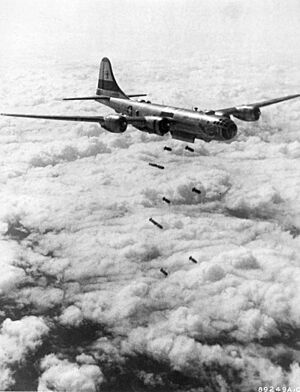
The Korean War is best known for jet combat. But it was also one of the last big wars where propeller-powered fighters were used. These included the North American P-51 Mustang and Vought F4U Corsair. Turbojet fighter planes like the Lockheed F-80 Shooting Star and Republic F-84 Thunderjet soon ruled the skies. They easily beat North Korea's propeller planes.
From 1950, North Koreans flew Soviet-made MiG-15 jet fighters. These planes brought near-sonic speeds and swept wings to air combat. During the war, it was an open secret that the most skilled pilots were experienced Soviet Air Force pilots. The UN forces knew this but did not want to start an open war with the Soviet Union and China.
At first, UN jet fighters, including Australian Gloster Meteors, had some success. But straight-winged jets were soon outmatched in daylight by the faster MiGs. At night, however, radar-equipped Marine Corps Douglas F3D Skynight night fighters shot down five MiGs without any losses of their own. No B-29 bombers under their protection were lost to enemy fighters.
In December 1950, the U.S. Air Force quickly brought in their own swept-wing fighter, the North American F-86 Sabre. The MiG could fly higher, 50,000 feet (15,000 m) versus 42,000 feet (13,000 m), which was a big advantage at the start of a fight. In level flight, their top speeds were similar, about 660 miles per hour (1,060 km/h). The MiG could climb better, while the Sabre could dive better. For weapons, the MiG had two 23 mm and one 37 mm cannon. The Sabre had six .50 caliber (12.7 mm) machine guns. The American guns, while not as powerful, carried many more rounds. They were also aimed with a more accurate radar-ranging gunsight. U.S. pilots also had G-suits, which were used for the first time in this war.
Even after the Air Force brought in the advanced F-86, its pilots often struggled against the jets flown by Soviet pilots, called "honchos." The UN slowly gained air superiority over most of Korea. This lasted until the end of the war. It was a key factor in helping the UN advance into the north and then resist the Chinese invasion of South Korea.
After the war, the USAF claimed 792 MiG-15s and 108 other planes shot down by Sabres, for the loss of 78 Sabres. Later research lowered the total to 379 victories. This is still higher than the 345 losses shown in Soviet records.
The Soviets claimed about 1,100 air-to-air victories and 335 combat MiG losses. China's official losses were 231 planes shot down in air-to-air combat (mostly MiG-15s) and 168 other losses. North Korea's air force losses were not revealed. It is thought they lost about 200 planes early in the war, and another 70 after China joined.
Soviet claims of 650 victories over Sabres, and China's claims of another 211 F-86s, are thought to be too high by the USAF.
The Korean War was the first time helicopters were used a lot in a conflict. While helicopters like the Sikorsky R-4 were used in World War II, it was rare. Jeeps were the main way to move injured soldiers. In the Korean War, helicopters like the Sikorsky H-19 started to take over for moving injured people out of combat zones.
Indo-Pakistani Wars
During the Indo-Pakistani War of 1965, the air forces of India and Pakistan fought each other fully for the first time. Both countries have different claims about how many planes they lost, and no neutral sources have confirmed them. The Pakistani Air Force (PAF) claimed 104 Indian Air Force (IAF) planes lost, while only losing 19 of their own. India, meanwhile, claimed they lost 35 planes while shooting down 73 Pakistani planes. In this war, the larger IAF could not gain full control of the air over the PAF, which had better quality planes. So, the war in the air was a stalemate.
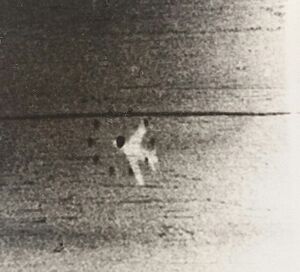
By the time of the Indo-Pakistani War of 1971, the Indian Air Force had both more planes and better quality ones. They had new Mikoyan-Gurevich MiG-21s and Sukhoi Su-7s. On the other side, the PAF had new planes like the Shenyang J-6 and Dassault Mirage III. The war started with Operation Chengiz Khan, Pakistan's surprise attack on 11 Indian airbases on December 3, 1971. After this first attack, the PAF took a defensive position because of India's retaliation. As the war went on, the IAF kept fighting the PAF over conflict zones. But the number of flights by the PAF slowly went down each day. The Indian Air Force flew 4,000 missions, while the PAF flew 3,300. This was partly because they had fewer non-Bengali technical staff. In East Pakistan, the PAF's only squadron was eventually grounded. This happened when the Tezgaon airfield in Dhaka was put out of action after seven days of repeated bombings by Indian MiG-21s, Hunters, and Su-7s. This allowed the IAF to gain control of the air in the East.
Vietnam War: Helicopters and New Tactics
The Republic of Vietnam Air Force (VNAF) first had helicopters like the Piasecki H-21 and propeller planes like the North American T-28 Trojan. Jet planes were not allowed by treaty. As the U.S. got more involved, most planes were flown by U.S. forces.
The U.S. Army used helicopters a lot in Vietnam. This led to a new type of airmobile troops and "Air Cavalry" in the U.S. The Bell UH-1 Huey helicopter became a symbol of the war. The Sikorsky CH-54 Tarhe "Skycrane" and Boeing-Vertol CH-47 Chinook lifted heavier loads like vehicles or artillery. Troops could land by surprise, attack, leave quickly, and evacuate wounded. The special AH-1 Cobra attack helicopter was made from the Huey for escort and ground support. Later, the Soviet Union also used helicopters widely in Afghanistan.
U.S. forces provided close support to ground troops over South Vietnam. They also bombed targets in North Vietnam. Many planes flying close support or counter-insurgency missions were propeller-powered. These included spotter planes like the Cessna O-1 Bird Dog and North American OV-10 Bronco, and attack planes like the Douglas A-1 Skyraider and Douglas B-26 Invader. The Douglas AC-47 Spooky was a gunship. Transport planes like the Fairchild C-123 Provider and Lockheed C-130 Hercules flew supplies into battlefields like Khe Sanh.
"Fast movers" included the supersonic North American F-100 Super Sabre. The giant Boeing B-52 Stratofortress was changed to drop huge amounts of high explosives on enemy troop groups. The Lockheed AC-130 became the ultimate gunship. The AX plane, meant to replace the Skyraider, became the Fairchild Republic A-10 Thunderbolt II.
USAF Republic F-105 Thunderchiefs flew most of the bombing missions against North Vietnam in Operation Rolling Thunder. Carrier-based Douglas A-4 Skyhawks were flown by the Navy. This first bombing campaign had strict rules that limited attacks on missile sites and fighter bases. It also had frequent bombing pauses, and it didn't achieve much politically. Rolling Thunder was the first time electronic computers on ships were used to show real-time plane positions for commanders.
Lessons learned were used in the later Operation Linebacker. This operation used McDonnell Douglas F-4 Phantom IIs, B-52s, General Dynamics F-111 Aardvarks, LTV A-7 Corsair IIs, and Grumman A-6 Intruders. It was more successful in bringing North Vietnam to peace talks after a huge ground invasion. North Vietnam effectively combined Soviet and Chinese anti-aircraft guns, SA-2 guided missiles, and MiG fighters. This created the most heavily defended airspace up to that time.
U.S. air strikes combined the use of airborne radar planes like the Lockheed EC-121 Warning Star, Boeing KC-135 Stratotankers for air refueling, radar jamming planes, and special "Wild Weasel" units to attack SAM missile sites. Jolly Green Giant helicopter crews, escorted by Douglas A-1 Skyraiders, rescued downed pilots over enemy territory. With the use of "smart" guided bombs late in the war, this set the pattern for future U.S. air operations.
Experts were surprised when advanced F-105s were shot down in their first fight against the older but agile MiG-17. Dogfights were thought to be old-fashioned in the age of missiles. But pilots now needed planes that could maneuver well. The McDonnell Douglas F-4 Phantom II was quickly given the job of protecting against MiGs. But it didn't have a built-in gun, and missiles were still very unreliable. Air combat training schools like TOPGUN improved kill ratios. Combat experience led to programs that would produce agile air superiority fighters with guns, like the McDonnell Douglas F-15 Eagle, by the 1970s.
South Vietnam fell in 1975 without U.S. air support when faced with a massive attack. The VNAF was never given powerful fighters and bombers like the F-4 Phantom and B-52 that could strike North Vietnam.
Middle East Conflicts
In the Six-Day War of 1967, the Israeli Air Force launched surprise attacks. They destroyed opposing Arab air forces on the ground. The Yom Kippur War of 1973 saw Arab forces use mobile 2K12 Kub (SA-6) missiles. These missiles were effective against low-flying Israeli planes until ground forces destroyed them.
Iran–Iraq War
In the Iran–Iraq War (1980–1988), aerial warfare was constant. At the start, Iraq tried to destroy the Islamic Republic of Iran Air Force by bombing its airfields. But they failed because of poor pilot training and strong Iranian air base defenses. This war also saw the first helicopter-versus-helicopter fights between the Iraqi and Iranian air forces.
Falklands War (1982)
During the six-week Falklands War, British carrier-based British Aerospace Sea Harrier and Hawker Siddeley Harrier planes flew over 1,500 missions. Avro Vulcan bombers flew long-range bombing missions. British Harriers and Sea Harriers destroyed 21 Argentine planes in the air. British Surface to Air Missiles destroyed 18 more Argentine planes. Another 15 Argentine planes were destroyed on the ground, and 14 were captured. In total, 68 Argentine planes were captured or destroyed by British Forces. This was 28% of the 240 planes Argentina had at the start of the war. Including accidents and friendly fire, 31% of their total planes were lost.
Modern Air Warfare
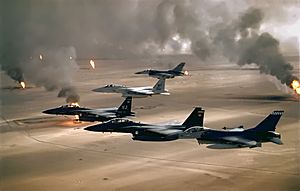
When the Soviet Union collapsed in 1991, Western air forces changed. They moved from needing huge numbers of planes during the Cold War to having fewer, multi-role aircraft. The closing of military bases overseas showed how effective aircraft carriers are when there are no dedicated military airfields. The Falklands War and U.S. operations in the Persian Gulf highlighted this.
The invention of precision-guided munitions (smart bombs) allowed for very accurate attacks on any target on the ground, once it was located.
The Stockholm International Peace Research Institute (SIPRI) has noted that selling combat aircraft can make regions unstable. This is because they can quickly attack neighboring countries, like when Israel attacked Syria in Operation Orchard in 2007.
Gulf War (1991)
The role of air power in modern warfare was clearly shown during the Gulf War in 1991. Air attacks hit Iraqi command centers, communication facilities, supply depots, and troop reinforcements. Control of the air over Iraq was gained before major ground fighting began.
The first attacks used Tomahawk cruise missiles launched from ships. Lockheed F-117 Nighthawk stealth bombers dropped laser-guided bombs. Other planes used anti-radar missiles. These first attacks destroyed Iraq's air defense network. This allowed fighter-bombers to gain control of the air over the country.
Fairchild Republic A-10 Thunderbolt IIs attacked Iraqi armored forces with Gatling guns and Maverick missiles. They supported the advance of U.S. ground troops. Attack helicopters fired laser-guided Hellfire missiles and TOW missiles. The Allied air fleet also used AWACS planes for radar surveillance and Boeing B-52 Stratofortress bombers.
The air strike force had over 2,250 combat aircraft, including 1,800 U.S. planes. They fought against an Iraqi force of about 500 planes, mostly MiG-29 and Mirage F1 fighters. More than 88,000 combat missions were flown by Allied forces. Over 88,000 tons of bombs were dropped by the end of the fifth week.
Kargil War (1999)
On May 11, 1999, the Indian Air Force was asked to provide helicopters to support the Indian Army during the Kargil conflict with Pakistan. The PAF was not directly involved in this conflict. So, the IAF focused all its efforts on ground operations without enemy air resistance. The first attacks were on May 26. The Indian Air Force struck enemy positions with fighter aircraft and helicopter gunships. The first strikes used MiG-27s for attacks, with MiG-21s and MiG-29s providing fighter cover. The IAF also used radars and MiG-29 fighters to watch Pakistani military movements across the border.
On May 27, the IAF lost a MiG-21 to enemy action and a MiG-27 to a mechanical problem. The next day, a Mi-17 helicopter was lost to SAMs during an attack mission. These losses forced the IAF to stop using helicopters for attacks. On May 30, the IAF brought in the Mirage 2000. This plane was considered the best for high-altitude conditions. Mirage 2000s had better defenses than the MiGs. They also gave the IAF the ability to carry out air raids at night. Indian MiG-29s were used a lot during the 1999 Kargil War in Kashmir. They provided fighter escort for Mirage 2000s, which were attacking targets with laser-guided bombs. The Kargil Conflict ended with a clear Indian military and diplomatic victory.
Eritrean–Ethiopian War (1998–2000)
The Eritrean–Ethiopian War was the first war where 4th-generation jet fighters fought each other. Most of the Eritrean MiG-29 losses were caused by dogfights with Ethiopian Su-27s.
Iraq War (2003–2011)
During the 2003 invasion of Iraq by U.S. and British forces, air warfare continued to be very important. The U.S.-British alliance started its air campaign on March 19 with limited nighttime bombing of Baghdad, the Iraqi capital. Several days later, intense bombing began. About 14,000 missions were flown. Over 800 Tomahawk cruise missiles, each costing $1 million, were fired at many targets in Iraq from March 19 until mid-April 2003. By this time, Iraqi resistance had mostly ended.
Iraqi anti-aircraft weapons could not fire on high-altitude U.S. bombers like the B-52 or stealth planes like the B-2 bomber and the F-117A. U.S. and British planes used radar-detecting devices and air scouting to find Iraqi anti-aircraft weapons. "Bunker buster" bombs, designed to break through and destroy underground bunkers, were dropped on Iraqi command centers. Iraqi ground forces could not seriously challenge the American ground forces because the U.S. had complete control of the air. By mid-April 2003, U.S.-British forces controlled all of Iraq's major cities and oil fields.
2006 Lebanon War
At the start of the 2006 Lebanon War, Israel launched a strong air campaign. Its goal was to eliminate Hezbollah and destroy its military, as stated by Israeli prime minister Ehud Olmert. It also aimed to get kidnapped Israeli soldiers back. The campaign began by destroying Lebanese infrastructure and Hezbollah targets. This continued for the 33 days of the war.
Compared to the results of the 1991 and 2003 wars in Iraq and the 1999 war in Yugoslavia, the Israeli air force was not able to fully achieve its goals. This was partly because of Hezbollah's military strategy, which proved effective. There were also reports during the conflict that a Hezbollah-operated flying drone entered Israeli airspace and returned to Lebanon.
2022 Russian Invasion of Ukraine
The Russo-Ukrainian War in 2022 became the first conflict in two decades to feature large-scale aerial warfare.
Also, the conflict in Ukraine has seen a new type of air warfare. This involves small, cheap civilian drones (usually quadcopters) that have been changed to attack enemy positions. These include buildings, vehicles, and trenches. These attacks often involve changing drones to drop explosives like grenades. Or, the drone itself is equipped with explosives and flown directly into enemies to self-destruct.
This is different from earlier warfare with unmanned aerial vehicles (UAVs). These new drones are easily available in large numbers to civilians. They also need much less space and resources to operate compared to bigger, traditional UAVs. Besides being much easier for civilian fighters to get, and having almost no risk of casualties for the attacker, they offer quick, very accurate attacks at a much lower cost than traditional UAVs. This makes them perfect for the urban warfare seen in Ukraine. Most of these attacks are by Ukrainians against Russian invaders.
See Also


